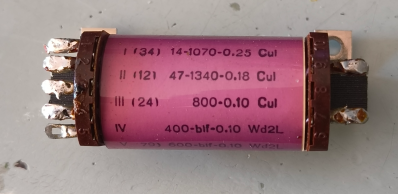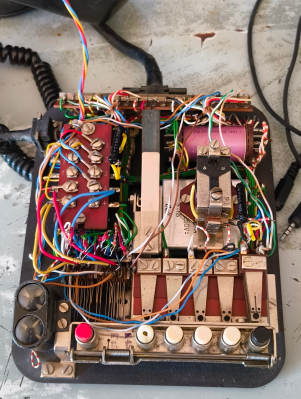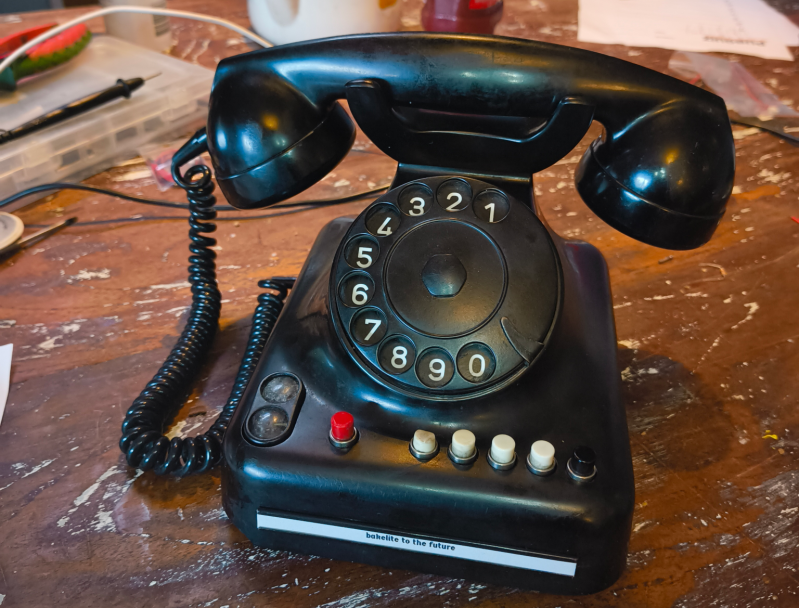A decade ago, [Jouke Waleson] bought a Dutch ‘model 1950’ PTT (The Dutch Postal Service) rotary-dial telephone of presumably 1950s vintage manufactured by a company called Standard Electric, and decided it would be neat to hack it to function as a Bluetooth hands-free device. Looking at the reverse, however, it is stamped “10.65” on the bottom, so maybe it was made as recently as 1965, but whatever, it’s still pretty old-tech now.

The plan was to utilise ESP32 hardware with the Espressif HFP stack to do all the Bluetooth heavy lifting. [Jouke] did find out the hard way that this is not a commonly-trodden path in hackerland, and working examples and documentation were sparse, but the fine folks from Espressif were on hand via GitHub to give him the help he needed. After ripping into the unit, it was surprisingly stuffed inside there. Obviously, all the switching, even the indication, was purely electromechanical, which should be no surprise. [Jouke] identified all the necessary major components, adding wires and interfacing components as required, but was a bit stumped at the function of one funky-looking component that we reckon must be a multi-tap audio transformer, oddly finished in baby pink! After renovating some interesting cross-shaped mechanical indicators and wiring up some driving transistors, it was time to get on to the audio interface.
Initially, [Joike] planned to use an INMP441 I2S digital microphone module, but this was incompatible with the standard ESP32 HFP client (used for Bluetooth hands-free support), so [Jouke] pivoted and used a WM8782-based ADC board for audio input. This also allowed the existing microphone to be used simply by biasing

it to 5 Volts and hooking it straight up to the ADC board via a coupling capacitor. This was a happy outcome, as the modern digital microphone would have sounded very different to the original equipment! On the speaker side, a PCM5102 I2S audio DAC module was pressed into service. The ringer/buzzer needed seven volts, so adding a boost converter board was also necessary. It’s a minor annoyance for powering a single device, but this is a one-off hack, so it’s no big deal. Finally, the backplate was modified to add a USB-C module and a power switch so it could be power-cycled, giving access to the ESP32 boot loader and enabling firmware updates without opening the case.
The outfit’s brains are courtesy of a LilyGo T-Koala board, a basic breakout board based around the older ESP32-WROVER module. This was necessary as the newer ESP32 chips drop Bluetooth classic support and, with it, support for handling the Bluetooth hands-free protocol. We were particularly ticked by the project tagline, “Bakelite to the future”, and that lifting the phone when not answering an incoming call connects you to Google Assistant or Siri! Nice work! For a look over the source code for the project, check out the GitHub page.
This is not the first modernisation of a classic telephone, and we hope it won’t be the last. Here’s an older GSM-based hack. If all this talk of rotary phones and tethered handsets confuses you, here’s our guide to this older telephone system. Telephones weren’t the only old-school home appliances constructed from Bakelite—far from it. It was also used to make many radios.
















Must have been for a multi-line office use. I like seeing no letters!
Coiled cord not historic or tangle resistant.
Creator here: cord is historic, took quite some time to untangle it when I first got it.
The coiled cord is historic as far as I know! I spent quite some time untangling it.
Interesting project, but out of curiosity, what would the reason be not to make an adapter you can plug the cord into instead of modding the phone? My personal preference is usually to leave old things as they are… May be just me.
The voltage of the system was very very different so that would complicate matters a lot. My goals (not stated in the blog post) were also to have the original functionality, a very clean design and no external components. A “sleeper phone” if you will.
I get the preservationist feelings too, but there’s plenty of old phones still available and not many people doing these kind of conversions. I’d worry more about them ending up in the garbage.
Yes. And you can actually buy adapters to run such a phone on a modern VOIP line. I use two of them in my house with the ancient German “W49” (1949 model) phones. Works like a charm, and no ancient hardware is harmed in the process :-)
This ,except wired into the old copper
phone system and putting rotory/push button phones where conivienient, and then just put the cell phone down when at home
and still get calls
I dont know about anyone else,but when I get in the house,I empty my
pockets, and often change into clothes that dont have a phone pocket
though of course there would be explaining to do, “no I cant see your text”, “sorry my device cant open your url”,which is of course just going
to mess with some people
Indeed, I hope to use this to beat my phone addiction and put this on my nightstand instead of my smartphone :)
been out for years, ex: https://www.amazon.com/bluetooth-landline-adapter/s?k=bluetooth+landline+adapter
Buried the lead:
“Most importantly: I can once again slam down the phone if I’m having an angry phone call. Which I never have, but still.”
That was always satisfying.
Back in the day, it was considered an art form with actual benefits
It needs to have a 0.5 second delay on hangup so that when you slam the phone down, the other end can hear it.
Programmed it like that ;) https://github.com/jtwaleson/bakelite-to-the-future-esp32/blob/04dead38b9b5a57a350f33708ff90a2b4cc043d0/main/button_handlers.c#L171
That “transformer” is the audio fork. It’s what separates/combines the incoming and outgoing speech so you will only hear the person on the other side and not yourself on the speaker in the horn.
https://nl.m.wikipedia.org/wiki/Telefoonvork
Sorry I could only find this in Dutch, this is the use for amplification at the central side, but it works the same in the handset. Quite a clever bit of tech.